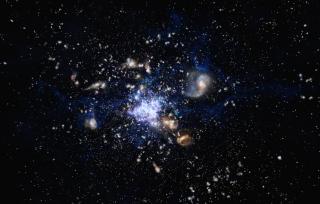Bibcode
Díaz-Sánchez, A.; Dannerbauer, H.; Sulzenauer, N.; Iglesias-Groth, S.; Rebolo, R.
Referencia bibliográfica
The Astrophysical Journal
Fecha de publicación:
9
2021
Revista
Número de citas
3
Número de citas referidas
2
Descripción
We report an ultrabright lensed submillimeter galaxy at zspec = 1.4796, identified as a result of a full-sky cross-correlation of the AllWISE and Planck compact source catalogs aimed at searching for bright submillimeter galaxies at z ~ 1.5-2.8. Atacama Pathfinder Experiment (APEX)/LABOCA observations of the candidate galaxy reveal a source with flux S870μm = 54 ± 8 mJy. The position of the APEX source coincides with the position of the AllWISE mid-IR source and with the Einstein ring GAL-CLUS-022058s, observed with the Hubble Space Telescope. Archival VLT/FORS observations reveal the redshift of this Einstein ring, zspec = 1.4796, and the detection of the CO(5-4) line at zspec = 1.4802 with APEX/nFLASH230 confirms the redshift of the submillimeter emission. The lensed source appears to be gravitationally magnified by a massive foreground galaxy cluster lens at z = 0.36. We use Lenstool to model the gravitational lensing, which is close to a "fold arc" configuration for an elliptical mass distribution of the central halo, where four images of the lensed galaxy are seen; the mean magnification is μL = 18 ± 4. We have determined an intrinsic rest-frame infrared luminosity of LIR ≍1012L⊙ and a likely star formation rate of ~70-170 M⊙yr-1. The molecular gas mass is Mmol ~ 2.6 × 1010M⊙ and the gas fraction is f = 0.34 ± 0.07. We also obtain a stellar mass log (M*/M⊙) = 10.7 ± 0.1 and a specific star formation rate log (sSFR/Gyr-1) = 0.15 ± 0.03. This galaxy lies on the so-called main sequence of star-forming galaxies at this redshift.
Proyectos relacionados

Gas Molecular y Polvo en Galacias através del Tiempo Cósmico
Dos cuestiones fundamentales en la Astrofísica son la conversión de gas molecuar en estrellas y cómo este proceso físico depende del entorno en todas las escalas, desde sistemas planetarios, cúmulos estelares, galaxias hasta cúmulos de galaxias. El objectivo principal de este proyecto es el de estudiar la formación y evolución de galaxias a partir
Helmut
Dannerbauer